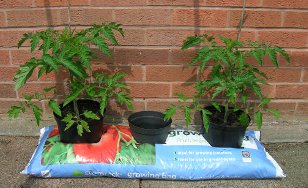Growing tomatoes outside poses a number of challenges that the greenhouse grower can ignore completely or be less concerned about.

Outdoor disadvantages:
- Rain – Wet leaves can cause blight and other fungal diseases during prolonged periods of wet weather.
- Temperature – Low night temperatures can cause all sorts of problems including poor flower set, nutrient deficiency and slow growth.
- Wind – Can cause stress and damage to fine roots around the base of plant stems, unless young plants are supported.
Outdoor advantages:
- Better pollination from bees etc. – getting flowers to set inside a greenhouse or polytunnel can be an issue – less of a problem if growing outside!
- Good aeration – A gentle breeze is ideal and helps to keep leaves dry and healthy.
- More light – Good levels of light is one of the most important requirements for tomato plants.
Timing from seed to planting
Tomatoes are sown indoors March/April for outdoor growing in the UK, where the last frost is expected around the end of May.
Extra protection
If I put my plants out at the end of May, I’ll cover them with garden fleece at night until night-time temperatures warm up a bit. However, if you have enough room indoors, it is better to keep them under cover until the beginning of June before putting them out.
Hardening off when growing tomatoes outside
Plants need time to adjust to lower temperatures, more breeze and higher light levels. Tomato plants are easily stressed so getting them used to outside conditions gradually, over a period of a week or so, will help keep them happy and growing at a consistent rate.
Choose at least one variety quick to mature
Tomato plants grow very quickly in favourable conditions, so starting a bit later when temperatures and light levels are better is a good idea. If you start too late of course, tomatoes won’t be ripe at the end of the season. Choosing at least one variety that is quick to mature is a good plan!
Outdoor Varieties
Some varieties are better able to cope with the wide variations of outdoor conditions such as temperature, humidity and wind. Most seed packets indicate if a variety is better grown in a greenhouse or outside in the garden.
Although yield may be lower, it is often the case that outdoor tomatoes taste better from hardier plants. See also: Tomato Varieties
A sheltered spot
Choosing a sheltered sunny position, preferably south or south west facing is also helpful. Growing tall varieties up against a wall that absorbs the warmth from the sun will help keep temperatures higher, longer.
Containers for outdoors – pot stability
Stability is an issue when growing bush varieties in large pots. On a windy day, pots are easily blown over, so choosing pots of the right shape can help. Wide top and narrow bottoms are the easiest to blow over! Adding extra weight to pots in the form of sand or gravel can help stability and improve drainage.
Compost weight
A soil based compost such as John Innes is heavier then soilless compost so it is good for containers. The disadvantage is carrying it home from the garden centre!
The biggest challenge
The biggest challenge when growing tomatoes outside in the UK is wet weather.
Wet leaves on tomato plants that remain wet for more than a day or two become vulnerable to blight.
Blight is a fungal disease that can destroy tomato plants, starting with the leaves then stems and fruit.
At last – a blight resistant tomato!
Gardeners have struggled for years during periods of wet weather but now there is an answer to their prayer – a blight resistant tomato variety called Crimson Crush. This variety is available from Suttons Seeds more info here.

